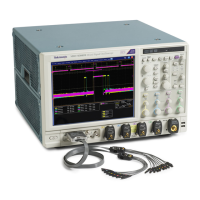Command Groups
Command
Description
SELect:<wfm> Turns on the specified waveform
Or returns whether the specified channel is
on or off
SELect:CH<x
>
Sets or queri
es the displayed state of the
specified channel waveform
SELect:CONTROl Sets or returns the w aveform controlled by
the front panel
Wa veform Transfer Command Group
Use the co
mmands in the Waveform Transfer Command Group to transfer
waveform data points to and from the instrument. Waveform data points are a
collection of values that define a waveform. One data value usually represents
one data point in the waveform record. When working with envelope waveforms,
each data value is either the minimum or maximum of a min/max pair.
Before you transfer waveform data, you must specify the data format, record
length, a nd waveform source.
Data F
ormats. Acquired waveform data uses eight or more bits to represent each
data point. The number of bits used depends on the acquisition mode specified
when you acquired the data. Data acquired in SAMple or ENVelope mode uses
eight bits per waveform data point. Data acquired in AVERage mode uses up to
14 bits per point.
The instrument can transfer waveform data in either ASCII or binary format.
You specify the format with the DATa:ENCdg command. The instrument uses
signed, 4 byte integers a nd floating point values; it does not support unsigned
flo
ating point values.
ASCII data is represented by signed integer or floating point values. An example
A
SCII waveform data string may look like this:
CURVE<space>-110,-109,-110,-110,-109,-107,
-109,-107,-106,-105,-103,-100,-97,-90,-84,-80
Use ASCII to obtain more readable and easier to format output than binary.
However, ASCII may require more bytes to send the same values than it does with
binary. This may reduce transmission speeds.
Binary data can be represented by signed integer or floating point values. The
range of the values depends on the byte width specified. When the byte width is
one, signed integer data ranges from -128 to 127, and positive integer values
range from 0 to 255. When the byte width is two, the values range from -32768 to
32767. When a MATH (or REF that came from a MATH) is used, 32 bit floating
point values are u sed that are four bytes in width.
DPO7000, DPO70000/B and DSA7000/B Series Programmer Manual 2-67
